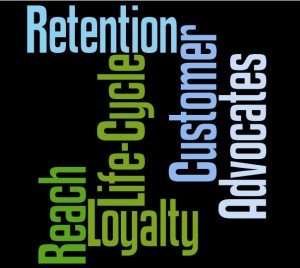When marketing, it's easy to get lost in the importance of customer acquisition and pay less attention to the customers that one already has. A smart business will blend the two together, spending even more energy on customer relationship management (CRM), or retention, than they do on acquisition. This is a formula for success, resulting in higher profit and not only a larger customer base, but a stronger one as well.
Why acquisition matters
Just because retention is most important doesn't mean that acquisition doesn't matter. Acquisition is needed to begin, maintain and grow any company. Here are just a couple of reasons why acquiring new customers is vital to any brand:

- More customers = a bigger business. The most obvious reason that acquisition is important is because any company needs new customers to survive. For this reason, acquisition is especially important to young businesses and those looking to expand their audience.
- Acquiring new customers likely means cutting into the competition. Grabbing the attention of a new audience doesn't only mean that a company is making money off of their business, but it also probably means that their competitors are not. Eighty-nine percent of consumers begin doing business with a competitor after leaving a company due to poor customer service. That means that acquiring consumers could mean a company is snagging them from a competing brand.
Why retention matters more
While acquisition is certainly important to any business, building brand loyalty and keeping existing customers is absolutely crucial. That's why companies like Preact and Retention Science both focus on helping businesses amp up retention rates (or "Preact" to keep their already existing clients). Here's why:
- It costs less to maintain an already-existing customer than it does to grab the attention of a new one. While the costs behind customer retention are far more complex than the costs surrounding custom acquisition, it actually costs less to market an already-loyal consumer.
- Retention efforts simply reach farther than acquisition ones. Plain and simple, it's easier to target an already-existing customer than it is to target a new one. The odds of making a successful sale to a loyal consumer can sit between 60% and 70%, but the chances of selling to someone new decrease to between 5% and 20%.
- Therefore, retention efforts typically make more money than acquisition ones. Not only does building brand loyalty make more money by costing less and requiring fewer resources, but also, loyal customers generally spend more money on each purchase. A new e-commerce buyer averages a checkout buy of under $25, but a returning one is likely to spend closer to $50.
So how can a company improve retention rate?
Improving retention rate takes a bit of rethinking and reshaping, but is ultimately a goal that all companies can achieve. The top three things great companies do to retain their customers are:
- Respond to customers in a timely matter. In many cases, when it comes to customer retention and satisfaction, response time matters even more than the actual response. In fact, 33% of consumers would prefer a quick response, even if it is an ineffective one. Shoot for hold times lower than three minutes and social media feedback within 60 minutes.
- Engage with your customers. Just because a customer made a purchase doesn’t mean your job is done. By engaging with them in an active way, you can drive up their brand loyalty, guaranteeing they return again and again. To engage with your customers, hold contests (both online and in person), ask for feedback through surveys and suggestions and then actually listen to the feedback and use it to shape your company’s direction.
- Customize and personalize. Customers like to feel that they’re appreciated. They want to feel like a person, not another dollar in your bank account. Plus, according to the 80/20 rule of business, 80% of your business will come from 20% of your customers. That means that it’s probably worth your time to get to know that 20% pretty well. Acknowledge them by name, throw in freebies wherever you can and never underestimate the impact of a “thank you” or a handwritten note.
By really honing in on these three skills, you have the ability to amp up retention and run a much more profitable business.
The bottom line: retention wins every time.
In an ideal world, a smart business would embrace both acquisition and retention, while placing a strong emphasis on retaining their customers. By building brand loyalty, businesses can cut back on marketing costs and resources in addition to actually drawing in a larger profit. That's why, while acquisition is a key part of business, retention should sit at the very center of any business model.

